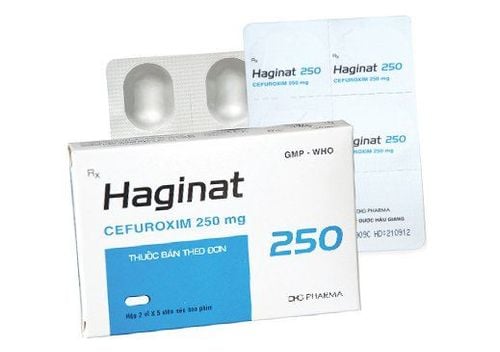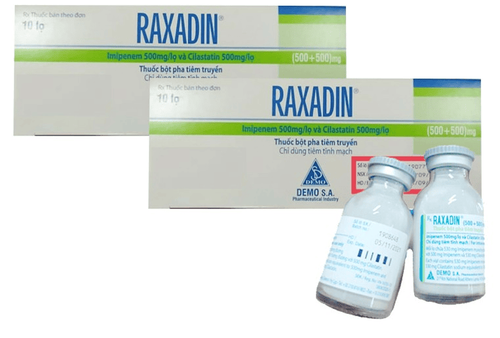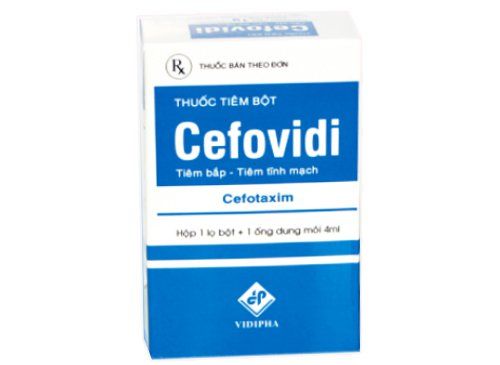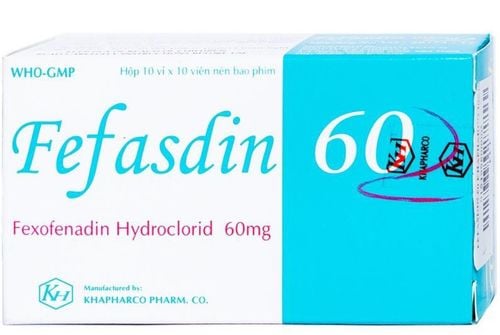This is an automatically translated article.
Hufotaxime is an antibiotic used by injection in cases of infections with bacteria sensitive to the antibiotic Cefotaxime. Learn about the use and note when using through the article below.
1. Uses of Hufotaxime
The main active ingredient is Cefotaxime 1g, which is prepared in the form of a powder for injection.
Cefotaxime is a 3rd generation cephalosporin antibiotic with a broad spectrum of antibacterial activity. Compared with cephalosporin antibiotics of the 1st and 2nd generation, cefotaxime is more active against Gram-negative bacteria, more stable to the hydrolysis of most beta lactamases. The antibacterial activity of cephalosporins is due to the inhibition of mucopeptide synthesis in the bacterial cell wall.
Hufotaxime drug has broad antibacterial effect on many different types of gram-negative and gram-positive bacteria.
2. Indications and contraindications to using Hufotaxime
2.1 Indications Hufotaxime is indicated in the treatment of infections caused by susceptible strains of bacteria:
Lower respiratory tract infections: including pneumonia, acute bronchitis and exacerbations Genital tract infections and urinary. Treatment of uncomplicated gonorrhea (neck/urethral and rectal) caused by Neisseria gonorrhoeae, including penicillinase-producing strains. Gynecological infections: Including pelvic inflammatory disease, endometritis, pelvic cellulitis. Sepsis caused by Escherichia coli, Klebsiella species, and Serratia marcescens, Staphylococcus aureus and Streptococcus species. Skin and skin structure infections caused by Staphylococcus aureus (including penicillinase-secreting and non-penicillinase-producing strains), Staphylococcus epidermidis, Streptococcus pyogenes and other streptococci... Intra-abdominal infections including peritonitis. Bone or joint infections caused by Staphylococcus aureus; Streptococcus species (including S. pyogenes* ), Pseudomonas species (including P. aeruginosa), and Proteus mirabilis. Central nervous system infections: Meningitis and encephalitis caused by bacteria such as Neisseria meningitidis, Haemophilus influenzae, Streptococcus pneumoniae, Klebsiella pneumoniae and Escherichia coli. Administration of Ceforoxime antibiotics before, during, or after surgery may reduce the incidence of infection in surgical patients at high risk of infection. 2.2 Contraindications Do not use the drug for patients who are hypersensitive to Cefotaxime sodium, or Penicillin, Cephalosporin antibiotics.
3. How to use and dose of Hufotaxime
3.1 How to use Intravenous administration: Dissolve 0.5g of Cefotaxime in 2ml of distilled water for injection or 1g of Cefotaxime in 4ml of distilled water for intravenous injection. The reconstituted solution can be injected in 3 to 5 minutes. Do not use sodium bicarbonate to make solution for injection. Intravenous infusion (higher dose): Dissolve 2g of Cefotaxime in 100ml of 0.9% NaCl solution or 5% glucose solution or separate intravenous solutions. The infusion time is 50 to 60 minutes. For short-term intravenous infusion, use 4ml of distilled water for injection or one of the above solutions and infuse over 20 minutes. Under no circumstances should sodium bicarbonate solution be used to make an infusion solution. Intramuscular: Dissolve 0.5 Cefotaxime in 2ml distilled water for injection or 1g Cefotaxime in 4ml distilled water for injection. The reconstituted solution should be injected deep intramuscularly in the buttocks. Do not inject more than 4ml for adults, and do not inject more than 2ml intramuscularly in children and infants. Intravenous administration is recommended when the daily dose exceeds 2g for adults and 100mg/kg/day for children and neonates, or in the case of 1g injection more than twice daily. For adults and children over 12 years old, cefotaxime can be mixed in 1% lidocaine solution (1g in 4ml) to avoid pain during intramuscular injection, but this solution mixed with lidocaine is not for intravenous use. 3.2 Dosage Adults and children over 12 years of age: Dosage and administration are determined based on the susceptibility of the causative organism, the severity of the disease and the patient's condition. The maximum daily dose should not exceed 12g.
Uncomplicated gonorrhea: 1g intramuscular injection, once a day. Uncomplicated infections: Intramuscular or intravenous injection at a dose of 2g bait every 12 hours. Moderate to severe infections: 1g to 2g intramuscularly or intravenously every 8 hours. Very severe infections (sepsis or central nervous system): 2g IV every 6 to 8 hours. Very serious, life-threatening infection: Intravenous at a dose of 2g every 4 hours. Patients with cesarean section: The starting dose is 1g of Cefotaxime intravenously right after clamping the umbilical cord. The second and third doses are 1g of Cefotaxime intramuscularly or intravenously approximately 6 and 12 hours after the first dose. Infants and Children: The recommended dosage for young children is as follows
Infants (ages 0-1 months):
From 0-1 weeks of age: Use at a dose of 50 mg/kg per dose, every 12 hours , intravenous injection. From 1 to 4 weeks of age: 50mg/kg per dose, every 8 hours, intravenously. Dosage is the same for premature and full-term infants.
Infants and children (from 1 month to 12 years old):
For children with body weight less than 50kg: the recommended dose is 50-180 mg/kg/day IM or IV. Divide 4 to 6 times. Higher doses are used in the treatment of more serious and serious infections, including meningitis. Children with a body weight of 50 kg or more receive the usual adult dose, the maximum daily dose should not exceed 12 g of Cefotaxime. Elderly: Cefotaxime is excreted by the kidneys, the risk of toxic reactions may be greater in patients with renal impairment. Because the elderly often have impaired renal function, care should be taken when choosing a dose and monitoring the patient's renal function.
Patients with impaired renal function: In patients with an estimated creatinine clearance less than 5 ml/min, the maintenance dose should be halved. The starting dose is determined according to the susceptibility of the causative organism and the severity of the disease.
4.Undesirable effects of the drug Hufotaxime
Unwanted drug effects occur with a frequency greater than 1% of drug users experiencing side effects including:
Inflammation at the injection site after intravenous injection; causes pain, stiffness and sensitivity to pain at the injection site after intramuscular injection. Rash, pruritus, fever, eosinophilia, less commonly urticaria and anaphylaxis. Colitis, diarrhea. Symptoms of pseudomembranous colitis may appear during or after the patient is treated with Cefotaxime. Inform your doctor immediately of unwanted effects encountered while using the drug and after taking the drug.
5. Notes when using Hufotaxime
Some things to note when using Hufotaxime:
Be careful when using Cefotaxime antibiotic for patients with a history of gastrointestinal disease, especially patients with colitis. When taking or after taking the drug, if there are manifestations of pseudomembranous colitis, it is necessary to assess the risk in people with diarrhea to have appropriate treatment measures. Drugs for parenteral administration should be visually inspected for color changes prior to administration. Pregnancy: Although animal studies have not demonstrated adverse effects on fetal development, the safety of Cefotaxime in pregnant women has not been established. determined. Therefore, Cefotaxime should not be used in pregnant women, especially during the first trimester of pregnancy. Lactation: Cefotaxime is secreted in breast milk in low concentrations. Caution should be exercised when this drug is administered to a nursing woman. Overdose: Overdose reactions are possible and have been reported. Effects are not obvious, mainly laboratory changes. When an overdose is detected, symptomatic and supportive treatment should be instituted. Drug interactions: When taking the drug can occur interactions with many other drugs including diuretics furosemide, other antibiotics can increase the effect of kidney damage... Storage: The vial containing the dry powder medicine should be protected. Store in a tightly closed container, at a temperature below 30°C and away from direct light. It is best to use the medicine immediately after reconstitution and not to use the reconstituted solution after 24 hours. Reconstituted cefotaxime solutions for intravenous or intramuscular injection remain effective after 24 hours if stored at a temperature below 22 degrees Celsius, for 10 days if stored in a refrigerator (below 5°C). During storage, the drug solution may have a darker color than usual, but the effectiveness and safety of the drug will not be changed if the storage conditions are ensured. Hufotaxime is an injectable and powerful antibiotic, so it should only be used in severe infections or insensitive to oral antibiotics to avoid the risk of drug resistance.
Please dial HOTLINE for more information or register for an appointment HERE. Download MyVinmec app to make appointments faster and to manage your bookings easily.













